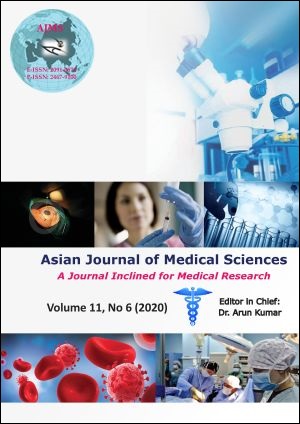Myocardial bridging in the course of coronary arteries and its clinical significance
Keywords:
Young individuals, Coronary artery, Sudden cardiac death, Anterior interventricular arteryAbstract
Background: Sudden death in young adults in absence of any risk factor related to coronary arterial disease has been reported. It could be because of some unrecognized congenital coronary artery anomalies like myocardial bridging. The clinician should keep myocardial bridging as a differential diagnosis in cases of sudden death in young individuals having no risk factors of coronary artery diseases.
Aims and Objective: The present study was conducted to know the prevalence of myocardial bridge and percentage of distribution of myocardial bridges in the course of different coronary arteries of cadaveric hearts.
Material and Methods: The study was conducted in the department of Anatomy, IMS, BHU Varanasi. Total numbers of 49 formalin preserved hearts were taken for the study. The hearts were meticulously dissected to see the distribution and location of myocardial bridge. Coronary arteries with myocardial bridge were photographed and data was statistically analyzed.Out of 49 hearts, 26(53.06%) showed myocardial bridging. Total numbers of bridges were found to be 34 in number. Among the 26 myocardial bridged hearts 8 hearts (30.76%) showed double myocardial bridges and 18 hearts (69.23%) showed single myocardial bridges. In hearts with double myocardial bridging, 5 of them showed myocardial bridging in the territory of both anterior interventricular artery (AIVA) and posterior interventricular artery (PIVA) and 3 showed bridging in the territory of anterior interventricular artery and its diagonal branch. Among the18 single myocardial bridging 16 were in the course of anterior interventricular artery and two showed myocardial bridging in one of the diagonal branch of AIVA. There were 24 myocardial bridges in the course of AIVA, 16 as a part of single myocardial bridged hearts and 8 as a part of double myocardial bridged heart with the percentage of distribution were 2 (8.33%)in the proximal 1/3rd,18(75%)were in middle 1/3rd and 4(16.66%) were in distal 1/3rd.
Conclusion: Due to the presence of high percentage of reported myocardial bridges in cadaveric hearts, the clinicians should always screen the young individuals and athletes having myocardial ischemia for the myocardial bridges along with other etiological factors.
Downloads
Downloads
Published
How to Cite
Issue
Section
License
Authors who publish with this journal agree to the following terms:
- The journal holds copyright and publishes the work under a Creative Commons CC-BY-NC license that permits use, distribution and reprduction in any medium, provided the original work is properly cited and is not used for commercial purposes. The journal should be recognised as the original publisher of this work.
- Authors are able to enter into separate, additional contractual arrangements for the non-exclusive distribution of the journal's published version of the work (e.g., post it to an institutional repository or publish it in a book), with an acknowledgement of its initial publication in this journal.
- Authors are permitted and encouraged to post their work online (e.g., in institutional repositories or on their website) prior to and during the submission process, as it can lead to productive exchanges, as well as earlier and greater citation of published work (See The Effect of Open Access).




